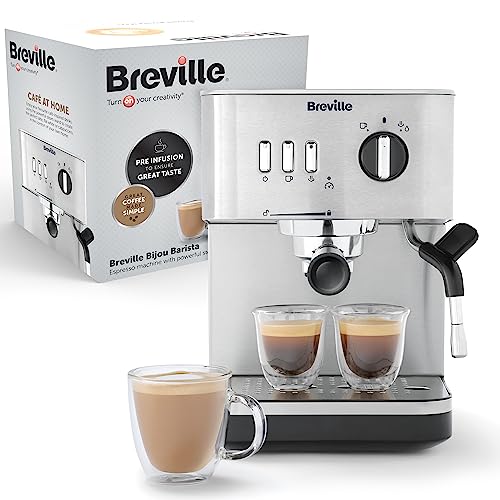Don't Buy Into These "Trends" About Machine Espresso
페이지 정보

본문
 How Does Machine Espresso Work?
How Does Machine Espresso Work?Machine espresso employs precise pressure and amazing filter technology to make the delicious coffee espresso machines we enjoy. What exactly is it?
Espresso is made by pushing hot water under pressure through finely ground coffee. The process is similar to making drip coffee but the difference is in the pressure.
The Group Head
As the name implies, the group head is where you place your portafilter while making espresso. It disperses water into the portafilter and regulates the pressure of the extraction. There are numerous kinds of group heads each with distinct advantages and disadvantages. Some are focused on temperature stability, some on pre-infusion options, and others are designed to control the lever. Some include a combination like the E61. This is a very popular choice for baristas since it provides multiple advantages in one package.
As you can see in the photo above, the group head has a number of notches. You place your portafilter in these notches and then twist the head to lock it. There is also a gasket made from rubber that resides inside the notches and helps create the seal when you insert your portafilter into the machine. The notches on the head permit an exact location of the portafilter which is crucial for an even extraction.
Apart from allowing you easily connect your portafilter, the group head is also responsible to maintain an even temperature. This is done by cycling hot water around the portafilter, and through the brew-basket, making sure that the temperature is constant to extract the coffee. It is important to remember that even a tiny variation can mean the difference between a good and a great espresso.
The Pump
The motorized pumps that are used in rotary espresso machines supply the nine atmospheric bar pressure needed for espresso extraction. This is different from manual piston machines that use a lever. This pressure is built up by pumping water through a heat exchanger and then through the ground coffee.
Pumps are typically less expensive and last for longer than piston-driven machines. However, both types of machines are susceptible to degrading because of frequent use and inadequate cleaning. They also make mechanically complex which can result in the cost of even the simplest models.
Some espresso machines can eliminate the pump entirely and employ steam pressure to create espresso. The drawback is that the same boiler that produces steam also raises the temperature of water until it reaches boiling and can result in over-extraction. In addition, these machines frequently have to restore their pressure between cups, which requires time and energy.
Many espresso machines employ an rotary or vibrating pump, which has a vibration model using a vibrating disc to create pressure and an rotary model that pushes hot water through the grounds at high speed. Both models can make excellent espresso, however the rotary models are quieter and more durable than vibration pumps.
The Boiler
The boiler is the component that heats the water to the optimal temperature to extract. The steam that is produced reaches the portafilter, which contains ground espresso beans and is then funneled down into the cup. During this process, the steam creates pressure that pushes through the grounds of the coffee. This results in a crema on top of the espresso. This is a sign of a good espresso.
There are three types of espresso makers, which differ in the type of pump they use and how hot the coffee is. There are various ways to control the amount of brew, as well as the size of the cup that can be made by the machine.
The first Espresso Machine Black Friday machines were steam-types. The first espresso machines were steam types. This resulted in the coffee tasting bitter and burnt. This is the reason why Milanese makers Luigi Bezzerra and Desiderio Pavoni created the modern espresso machines uk machine.
The most well-known espresso maker is a semi-automatic device that has an electric espresso maker pump. When people think of espresso machines, they picture these machines. Semi-automatic machines require you to grind and tamp the beans on your own The pump, however, regulates the flow of water and pressure. This is an excellent compromise between human touch and the mechanised accuracy.
The Filter
Typically, espresso machines have filters that separate the grounds of coffee when they pass through the hot water. The filter is also an essential element of the temperature control system, as it prevents the machine from overheating.
It also enhances flavor, since a filter lets you enjoy a longer bloom time. This helps the beans release their flavors and provides an opportunity for better extraction.
However, it is important to keep in mind that even a top filter can result in a poor cup of coffee, as the quality of the beans and extraction is important.
It's in this area that the magic occurs. This is what makes espresso taste so good. The grouphead, often referred to as the brew head, is where the portafilter (the thingy you put the coffee ground into) is placed when you're making espresso.
In the steam-driven espresso machine hot water is heated in an airtight tank to create steam, which is then pushed through the grounds with high pressure. These kinds of machines are typically less expensive and simpler to maintain than pump-driven models. They are however limited to create the perfect conditions for brewing as they only operate with 1-1.5 bar of pressure. The ideal shot requires 9-10 bars.
In recent years, compressed air-driven espresso machines have become more popular. They use an air compressor to push hot water across the ground and are more mobile than steam-driven electric espresso machines.
- 이전글What's The Job Market For Single Coffee Machine Professionals Like? 24.08.26
- 다음글9 Things Your Parents Teach You About Single Brew Coffee Machines 24.08.26
댓글목록
등록된 댓글이 없습니다.